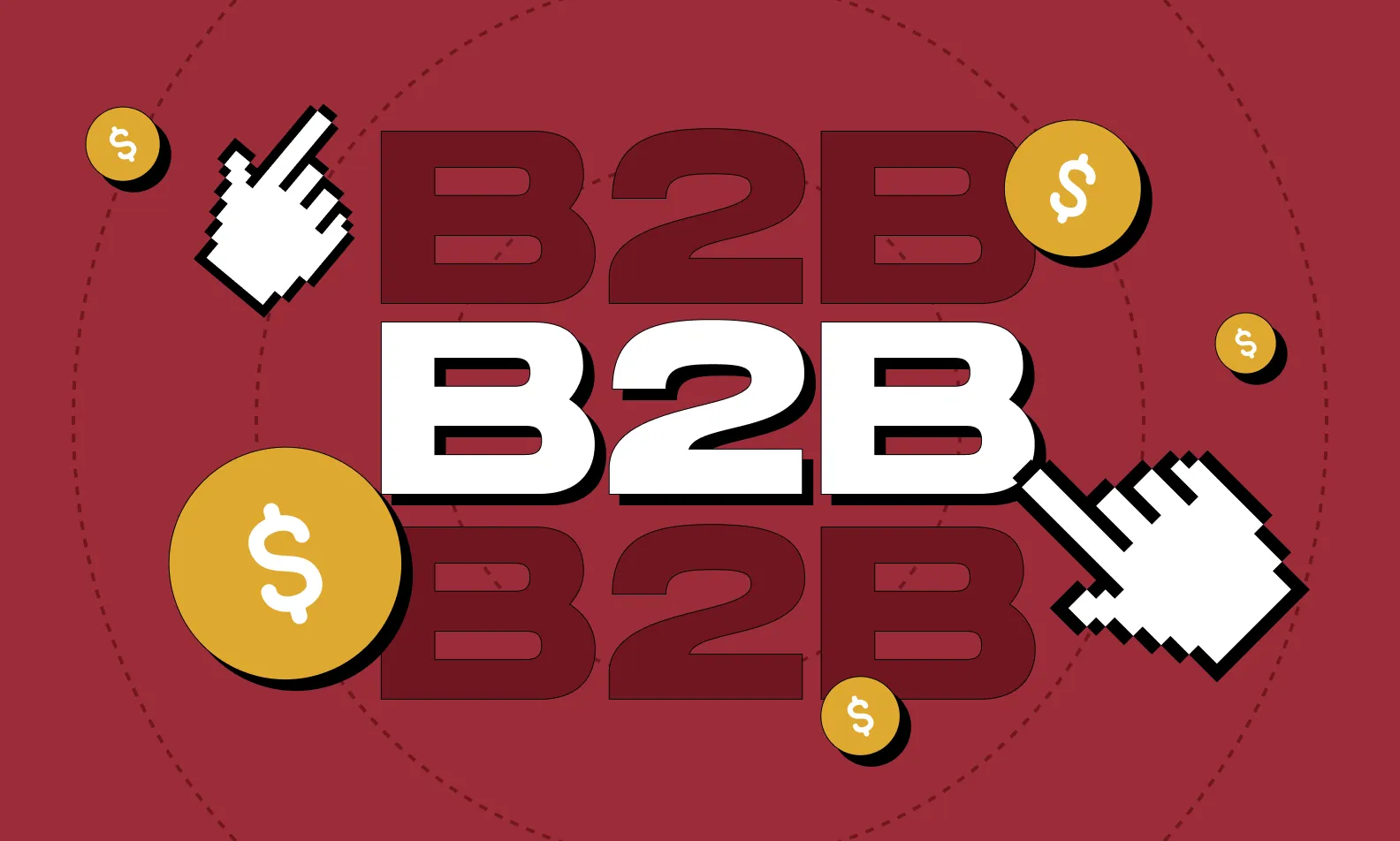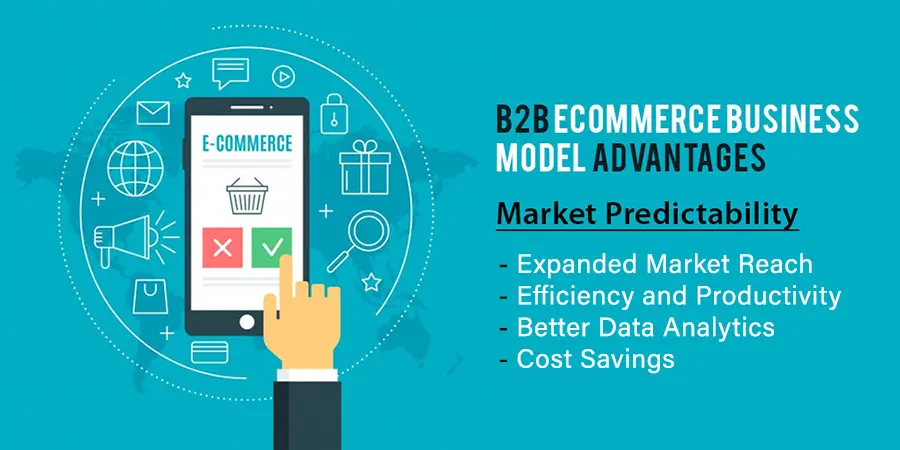What is B2B E-commerce? Everything You Need to Know

The growth of e-commerce has significantly impacted the way businesses approach transactions. B2B e-commerce is a crucial part of this transformation, enabling companies to purchase and sell goods or services online. In this article, we will discuss the fundamentals of the B2B e-commerce model by exploring its types, stages, and benefits for businesses and creators.
What Is B2B Ecommerce And How Does It Work?
Business-to-business (B2B) e-commerce refers to the online buying and selling of goods or services between businesses. Unlike Business-to-Consumer (B2C) e-commerce, where transactions occur directly between businesses and individual consumers, B2B e-commerce transactions involve businesses purchasing products or services from other businesses to support their operations, resell, or use as part of their value chain.
B2B e-commerce platforms provide a digital marketplace where businesses can connect, negotiate, and complete transactions efficiently, leveraging technology to streamline procurement processes, manage inventory, and expand their supplier networks.
In a B2B e-commerce ecosystem, businesses typically create accounts on online platforms specifically designed for B2B transactions. These platforms may be industry-specific marketplaces, general-purpose e-commerce websites, or proprietary systems developed by manufacturers, distributors, or wholesalers. Businesses can browse product catalogs, compare prices, place orders, and manage their accounts online, often with features such as bulk ordering, custom pricing, and integration with enterprise resource planning (ERP) systems for seamless transaction processing.
Sellers, on the other hand, use these platforms to showcase their products, manage inventory, communicate with buyers, and fulfill orders. They leverage digital tools to streamline operations and provide value-added services such as product customization, bulk discounts, and order tracking. B2B e-commerce platforms play a crucial role in facilitating trade between businesses, enabling them to reach new customers, optimize supply chain management, and drive efficiency and cost savings through digital transformation.
Benefits of B2B E-commerce

There are numerous benefits to implementing B2B e-commerce methodologies in a company's selling and distribution strategy. Here are a few advantages:
Expanded Market Reach
- Global Accessibility: B2B e-commerce breaks geographical barriers, allowing businesses to reach customers worldwide. Regardless of location, potential clients can access products and services with just a few clicks.
- Targeted Marketing: Through online marketing techniques like SEO, social media, and email campaigns, businesses can tailor their messages to specific audiences, increasing the likelihood of attracting relevant leads.
- Diverse Customer Base: By tapping into online channels, companies can attract a diverse range of customers, including those who prefer digital interactions over traditional methods.
Increased Efficiency and Productivity
- 24/7 Availability: Unlike brick-and-mortar stores, B2B e-commerce platforms operate round the clock, allowing customers to make purchases at their convenience. This constant availability enhances customer satisfaction and increases sales opportunities.
- Automation: Robust e-commerce systems can automate routine tasks such as order processing, invoicing, and inventory management. This not only reduces the risk of human error but also frees up employees to focus on strategic initiatives that drive growth.
- Streamlined Processes: By digitizing workflows, businesses can streamline their operations, leading to faster order fulfillment, reduced lead times, and improved overall efficiency.
Better Data Analytics
- Real-Time Insights: B2B e-commerce platforms provide access to real-time data analytics, offering valuable insights into customer behavior, purchasing patterns, and market trends. This data empowers businesses to make informed decisions and adapt quickly to changing market conditions.
- Personalization Opportunities: By analyzing customer data, businesses can personalize their offerings and marketing messages to better meet the needs and preferences of individual clients. This personalized approach enhances customer engagement and fosters long-term loyalty.
- Continuous Improvement: Data-driven insights enable businesses to identify areas for improvement and optimization, leading to iterative enhancements in products, services, and processes over time.
Cost Savings
- Reduced Transaction Costs: Online transactions typically involve lower fees compared to traditional offline methods, such as in-person sales or phone orders. This cost-saving benefit directly contributes to increased profitability for businesses.
- Lower Operational Expenses: B2B e-commerce reduces the need for physical storefronts, resulting in savings on rent, utilities, and maintenance costs. Additionally, process automation reduces labor expenses associated with manual tasks.
- Inventory Optimization: With real-time inventory tracking and management, businesses can avoid overstocking or understocking products, minimize inventory holding costs, and maximize inventory turnover.
- Decreased Marketing Expenditure: Digital marketing channels often offer a higher return on investment (ROI) compared to traditional advertising methods, enabling businesses to achieve greater marketing efficiency with lower budgets.
Types Of B2B E-commerce
Several types of B2B e-commerce businesses cater to different industries' needs. Here are the popular types of B2B e-commerce and brief descriptions of each:
Wholesale
Wholesale B2B businesses play a pivotal role in the supply chain by serving as intermediaries between manufacturers or producers and retailers. These wholesalers operate on a larger scale, buying goods in bulk from manufacturers at lower prices due to the volume of their orders.
By purchasing in bulk, wholesalers benefit from economies of scale, enabling them to negotiate lower prices and pass on these savings to retailers. This wholesale model facilitates the distribution of products to a wider network of retailers, helping manufacturers reach a broader market without the need to manage individual retailer relationships themselves.
Manufacturers
B2B manufacturers serve as the backbone of many industries, supplying raw materials, components, or finished products to other businesses across various sectors. These manufacturers play a crucial role in the production process, providing essential inputs that enable other businesses to create their own products or deliver services to their customers.
B2B manufacturers often specialize in specific industries or product categories, leveraging their expertise, technology, and economies of scale to produce high-quality goods at competitive prices. They may operate extensive production facilities, employing advanced machinery and processes to meet the demand for their products from other businesses.
B2B2C
B2B2C, or Business-to-Business-to-Consumer, represents a unique e-commerce model where businesses collaborate to reach end consumers through intermediaries. In a B2B2C arrangement, a business partners with another business to market and sell its products or services directly to consumers. This partnership enables the first business to leverage the second one's existing customer base, brand recognition, distribution channels, or online platforms to expand its reach and access a broader market.
Distributors
Distributors act as a bridge between producers and end consumers, offering services such as warehousing, logistics, marketing, and sales to ensure that products reach their intended destinations efficiently and effectively. These intermediaries typically purchase products in bulk from B2B manufacturers, wholesalers, or suppliers at wholesale prices.
By buying in large quantities, distributors benefit from economies of scale, enabling them to negotiate favorable pricing terms and pass on these savings to their customers. Once the products are procured, distributors assume responsibility for inventory management, storing the goods in warehouses until they are ready to be shipped to retailers or other buyers.
Stages Of a B2B Business
B2B businesses go through several stages throughout their lifecycle, each with specific needs and challenges. Here are the stages and their unique requirements:
Startup
At this stage, B2B businesses focus on building a strong foundation, cultivating business relationships, and generating leads. Startups need to identify their target audience, create a marketing strategy, and develop a robust website.
Growth
At the growth stage, B2B businesses expand their customer base, attain profitability, and establish brand awareness. Companies require robust CRM software, efficient supply chain management, and effective customer acquisition strategies.
Expansion
B2B businesses experience significant expansion in this stage, and businesses need to focus on retaining existing customers, expanding their product range, and investing in technology that supports business growth.
Maturity
At this stage, B2B businesses have a strong foothold in the market and require tactical planning and regular risk assessment. Companies should focus on diversifying their product range, expanding globally, and nurturing long-term business relationships.
8 Efficient B2B Marketing Tactics

Here are 8 top strategies every B2B e-commerce business should be using:
1. Content Marketing
Content marketing is a multifaceted strategy that involves creating and distributing valuable, relevant, and consistent content to attract and retain a target audience. This content can take various forms, including blog posts, articles, videos, infographics, whitepapers, and case studies, among others.
By providing valuable insights, educational resources, and solutions to common industry challenges, B2B e-commerce businesses can establish themselves as thought leaders and trusted advisors within their respective niches. Content marketing not only helps drive organic traffic to the website but also nurtures leads, builds brand credibility, and fosters long-term relationships with customers.
2. Account-Based Marketing (ABM)
ABM is a strategic approach that involves targeting specific high-value accounts or companies with personalized marketing campaigns tailored to their unique needs and preferences. This method focuses on building relationships and delivering customized content and messaging to key decision-makers within the target organizations.
When aligning marketing efforts with the objectives and challenges of individual accounts, B2B e-commerce businesses can increase engagement, improve conversion rates, and ultimately drive revenue growth. ABM enables businesses to maximize the impact of their marketing investments by prioritizing resources on the most promising opportunities and nurturing relationships with key accounts over time.
3. Search Online Optimization (SEO)
SEO is a fundamental component of any successful B2B e-commerce strategy, as it helps improve a website's visibility and ranking in search engine results pages (SERPs). By optimizing website content, structure, and technical aspects according to relevant keywords and search intent, businesses can attract organic traffic from search engines like Google, Bing, and Yahoo.
SEO tactics include keyword research, on-page optimization, backlink building, mobile optimization, and website performance optimization. By implementing SEO best practices, B2B e-commerce businesses can enhance their online presence, increase brand awareness, and drive qualified traffic to their website, ultimately leading to higher conversion rates and revenue.
4. Search Engine Marketing (SEM)
SEM complements SEO by incorporating paid advertising strategies to increase visibility and drive targeted traffic to a website. SEM typically involves pay-per-click (PPC) advertising campaigns on search engines like Google Ads or Bing Ads, where businesses bid on keywords relevant to their products or services. When users search for these keywords, the ads appear at the top of the search results, increasing the likelihood of clicks and conversions.
SEM allows B2B e-commerce businesses to reach potential customers at the precise moment they are actively searching for solutions, making it an effective strategy for generating leads and driving sales. Additionally, SEM offers granular targeting options, allowing businesses to tailor their ads to specific demographics, locations, and interests, thereby maximizing the return on investment (ROI) of their advertising spend.
5. Email Marketing and Automation
Email marketing remains a powerful tool for B2B e-commerce businesses to nurture leads, engage customers, and drive sales. By building targeted email lists and sending personalized messages to subscribers, businesses can deliver relevant content, promotions, and product recommendations directly to their audience's inbox.
Email automation further enhances efficiency by enabling businesses to set up automated workflows triggered by user actions or specific events, such as welcome emails, abandoned cart reminders, post-purchase follow-ups, and re-engagement campaigns. By segmenting their email lists based on customer preferences, behavior, and lifecycle stage, B2B e-commerce businesses can deliver more relevant and timely messages, improving engagement and conversion rates while nurturing long-term customer relationships.
6. Social Media Marketing
Social media platforms offer valuable opportunities for B2B e-commerce businesses to connect with their audience, build brand awareness, and drive engagement. By creating compelling content, participating in relevant conversations, and leveraging targeted advertising options, businesses can reach potential customers where they spend their time online.
Social media marketing allows businesses to showcase their products, share industry insights, and interact with customers in real-time, fostering trust, loyalty, and brand advocacy. Platforms like LinkedIn, Twitter, Facebook, and Instagram offer diverse features and advertising formats to suit different business objectives and audience demographics, enabling businesses to tailor their social media strategies to achieve their goals effectively.
7. Partnerships and Referral Programs
Collaborating with complementary businesses through partnerships and referral programs can be a mutually beneficial strategy for B2B e-commerce businesses to expand their reach, acquire new customers, and increase sales. By forming strategic alliances with suppliers, distributors, industry associations, or non-competing businesses, businesses can tap into each other's networks, resources, and expertise to leverage synergies and unlock new growth opportunities.
In addition, referral programs incentivize existing customers, partners, or affiliates to promote the business to their networks in exchange for rewards, discounts, or commissions. These programs encourage word-of-mouth marketing, build trust, and drive qualified leads, as referred customers are often pre-qualified and more likely to convert into paying customers.
8. Customer Experience Optimization
Providing an exceptional customer experience is paramount for B2B e-commerce businesses to differentiate themselves, retain customers, and drive repeat purchases. Customer experience optimization encompasses various elements, including website design, navigation, user interface, checkout process, and customer service. Businesses should prioritize creating intuitive, user-friendly websites with clear product information, easy navigation, and secure payment options to streamline the buying process and minimize friction.
Personalization tools and technologies allow businesses to deliver tailored experiences based on individual preferences, purchase history, and behavior, enhancing engagement and satisfaction. Additionally, proactive customer support, responsive communication, and hassle-free returns policies demonstrate a commitment to customer satisfaction, fostering trust and loyalty among B2B buyers. By continuously monitoring and optimizing the customer experience, businesses can identify areas for improvement, address pain points, and deliver value-added services that delight customers and drive long-term success.
Frequently Asked Questions
What is a B2B e-commerce business?
B2B e-commerce is a digital platform that facilitates the buying and selling of goods or services between businesses. This means businesses can transact with one another, typically in bulk orders, through various digital channels.
How is the B2B buyer journey different from that of B2C?
The B2B buyer journey usually involves multiple decision-makers, extended order cycles, and complex negotiations. In contrast, the B2C buyer journey is typically shorter, with fewer people involved in the decision-making process.
What are 4 examples of B2B e-commerce?
Four examples of B2B e-commerce businesses are wholesale e-commerce (Bulk purchasing of items by other businesses), SaaS B2B e-commerce (Software as a Service), Manufacturing e-commerce (Non-branded businesses selling components and raw materials), and distributors' e-commerce (Selling goods to multiple channels, including wholesale and retail).
Join Fourthwall and Find the Ultimate B2B Ecommerce Partner!
Fourthwall allows creators to sell and monetize their content while personalizing their stores with their B2B branding, including logos, photos, and videos. This makes it a seamless extension of their existing online presence.
Fourthwall's intuitive platform offers a range of B2B e-commerce features, such as flexible pricing options, streamlined order management, and secure payment processing. It makes it easy to launch your B2B e-commerce store and start selling to businesses worldwide. By partnering with Fourthwall, you'll have everything you need to succeed in B2B e-commerce.
















